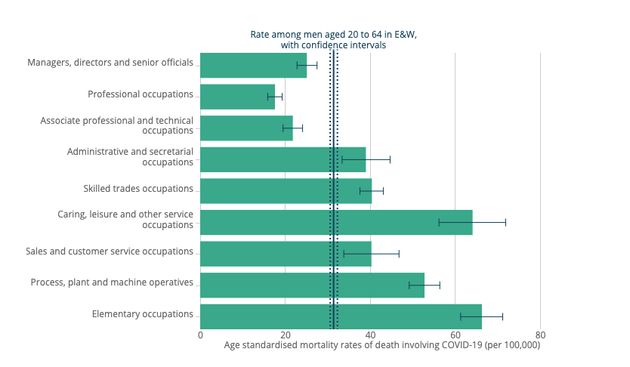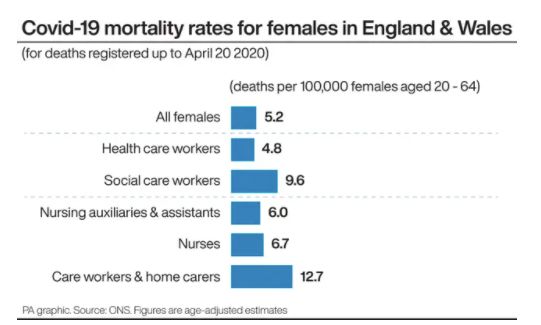Manual labourers, nurses and transport workers have some of the highest death rates involving Covid-19 compared to other professions, new figures suggest.
The figures differ for men and women but, according to the Office for National Statistics (ONS), manual labour had the highest death rate for men: 699 deaths per 100,000 male workers in that sector.
The figures, released on Monday, show how many people working in different industries died of coronavirus between March and December last year. It calculates a working age population of those aged 20 to 64.

But statisticians caution that the figures do not necessarily mean that their deaths were caused by the places they worked.
Male Covid deaths by occupation
These were the sectors with the highest death rates for men:
-
elementary occupations (manual labour) (66.3 deaths per 100,000 males in that sector; 699 deaths)
-
caring, leisure and other service occupations (64.1 deaths per 100,000 males in that sector; 258 deaths)
-
process, plant and machine operatives (52.8 deaths per 100,000 males; 827 deaths)
-
skilled trades occupations (40.4 deaths per 100,000 males; 848 deaths)
-
sales and customer service occupations (40.3 deaths per 100,000 males; 156 deaths)
-
administrative and secretarial occupations (39.0 deaths per 100,000 males; 186 deaths)
More specifically, these were the jobs with the highest death rates from Covid for men:
-
restaurant and catering establishment managers and proprietors (119.3 deaths per 100,000 males in that sector; 26 deaths)
-
metal working and machine operatives (106.1 deaths per 100,000 males; 40 deaths)
-
food, drink and tobacco process operatives (103.7 deaths per 100,000 males; 52 deaths)
-
chefs (103.1 deaths per 100,000 males; 82 deaths)
-
taxi and cab drivers and chauffeurs (101.4 deaths per 100,000 males; 209 deaths)
-
nursing auxiliaries and assistants (87.2 deaths per 100,000 males; 45 deaths)
-
elementary construction occupations (82.1 deaths per 100,000 males; 70 deaths)
-
nurses (79.1 deaths per 100,000 males; 47 deaths)
-
local government administrative occupations (72.1 deaths per 100,000 males; 23 deaths)
-
bus and coach drivers (70.3 deaths per 100,000 males; 83 deaths)
Female Covid deaths by occupation
These were the sectors with the highest death rates for men:
-
process, plant and machine operatives (33.7 deaths per 100,000 females; 57 deaths)
-
caring, leisure and other service occupations (27.3 deaths per 100,000 females; 460 deaths)
-
elementary occupations (21.1 deaths per 100,000 females; 227 deaths)
More specifically, these were the jobs with the highest death rates from Covid for women:
-
social workers (32.4 deaths per 100,000 females; 25 deaths)
-
national government administrative occupations (27.9 deaths per 100,000 females; 26 deaths)
-
sales and retail assistants (26.9 deaths per 100,000 females; 111 deaths)
-
managers and directors in retail and wholesale (26.7 deaths per 100,000 females, 24 deaths)
-
nursing auxiliaries and assistants (25.3 deaths per 100,000 females; 54 deaths)
-
nurses (24.5 deaths per 100,000 females; 110 deaths)
The figures cover the period from March 9 to December 28, 2020.
Covid-19 death rates for men and women working as teaching and educational professionals, such as secondary school teachers, were not statistically significantly raised compared with rates for the wider working population, the ONS found.
The rate for male teachers and educational professionals in England and Wales in 2020 was 18.4 deaths per 100,000, compared with 31.4 for all males aged 20 to 64; while for women it was 9.8 compared with 16.8.
For individual teaching occupations, the ONS said it was only possible to calculate a reliable rate for secondary education teaching professionals, with 39.2 deaths per 100,000 males and 21.2 per 100,000 females. The ONS said these were “not statistically significantly different than those of the same age and sex in the wider population”.
Similar data released in May last year found that male carers, bus drivers, chefs and retail assistants had higher rates of death involving coronavirus than other workers.

This is a breaking news story and will be updated. Follow HuffPost UK on Twitter, Facebook and Instagram.